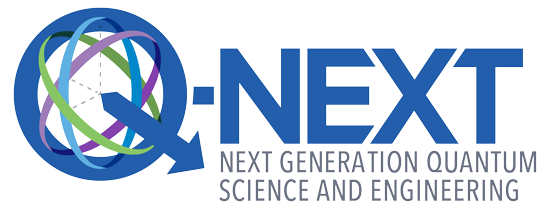Featured Collaborators
Scientists and engineers, early-career and established researchers, experts in industry and academia — all Q-NEXT collaborators contribute to the center’s mission to develop the science and technology for controlling and distributing quantum information, enabling pivotal discoveries and U.S. competitiveness in quantum science and engineering.
Learn about some of people who make up Q-NEXT:
Edward Schmitt
Facilities engineers like Edward Schmitt play a critical role in advancing scientific discoveries. For nearly two decades, Schmitt has maintained equipment and installed devices for materials scientists. Now, he’s establishing new infrastructure and systems to propel quantum research.
Read moreChloe Washabaugh
UChicago grad student Chloe Washabaugh creates high-performance qubits from designer molecules. Not only is she expanding the applications of quantum devices, but she’s also working to attract a diverse audience to quantum.
Read MoreMarco Pistoia
Marco Pistoia, head of JPMorgan Chase’s Global Technology Applied Research Center, leads a team of superstar scientists who are advancing quantum information technologies to improve financial portfolios and protect finance customers from cyberattacks.
Read moreJason Orcutt
A principal research scientist at IBM Quantum, Orcutt coordinates the development of long-range quantum interconnects, which link devices separated by meters to kilometers. He also provides an industry perspective on quantum simulation research at Q-NEXT.
Read moreGregory Grant
Gregory Grant, a graduate student at the University of Chicago, uses the Argonne Quantum Foundry and a molecular beam epitaxy machine to grow different types of crystals that can eventually be used in devices for quantum memory and quantum communication.
View MoreYuri Alexeev
Argonne scientist Yuri Alexeev uses supercomputers at the Argonne Leadership Computing Facility to develop quantum algorithms and simulate quantum computers, which are expected to be able to solve today’s most intractable problems.
View MoreJessica Barbosa Martins
Argonne postdoc Jessica Barbosa Martins controls the phenomena of quantum tunneling to develop materials for quantum communication. These materials will support quantum technologies that can securely carry information over long distances.
View moreStephen Gray
Argonne scientist Stephen Gray uses high-performance supercomputers to simulate the properties of materials that can exist in two opposite conditions at the same time and how they can interact and become quantum-entangled with one another.
View MoreJennifer Choy
Jennifer Choy of the University of Wisconsin–Madison is creating technologies to boost the performance of quantum sensors. Her work could lead to ultraprecise devices for navigation and for probing minuscule changes in a material’s electromagnetic field.
Read moreKatie Sautter
In graduate school, Argonne postdoctoral researcher Katie Sautter learned to master a machine that builds bits of matter one atomic layer at a time. Now she wields her considerable skills inventing materials for quantum communication devices at Q-NEXT.
Read moreThaddeus Ladd
A co-design engineer within Q-NEXT, Thaddeus Ladd of HRL Laboratories helps advance new materials for quantum science, develops simulations for quantum networks, and provides the perspective needed to assess how partners can best support the Q-NEXT mission.
Read moreElizabeth Goldschmidt
Goldschmidt’s lab is a playground for controlling particles of light to build new ways to store quantum information. A professor at the University of Illinois Urbana-Champaign, she’s helping develop the quantum communication technologies of the future.
Read moreJeanette Roberts
Intel’s Jeanette Roberts is helming the effort to install the company’s first quantum computing test bed at Argonne. Building a quantum computer is one of the biggest challenges of her career. And when she isn’t developing quantum devices, she’s either scuba diving or planning to.
Read MoreOpen Quantum Initiative fellows
Alejandro Aponte, Cody Castle, Ariadna Fernandez, Adrian Portales and Tiarna Wise conducted Q-NEXT research in 2022 as part of the Open Quantum Initiative Undergraduate Fellowship. Their work spanned quantum computing, communication, materials and sensing.
Read moreAntia Lamas-Linares
Antia Lamas-Linares of AWS is working to link the globe through quantum networks. She and her team explore how to store, control, compute and transmit photon-encoded information in ways that can’t be achieved through traditional computing and communication.
Read moreFeng Pan
Stanford University’s Feng Pan creates materials with sculptural features that manipulate light to encode information. His metamaterials are designed to produce chiral polaritons, particles can interact with one another in ways that are critical for quantum information storage.
Read moreBo Peng
Bo Peng of Pacific Northwest National Laboratory is pioneering new ways to beat down the noise in quantum computers. A researcher studying hybrid classical-quantum approaches to computing, he’s exploring different ways to reduce error in quantum devices.
